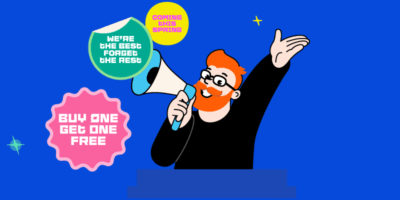Planning a campaign instead of firing ad hoc messages at your audience helps you improve performance and better control the outcomes of your marketing efforts. So, let’s have a look at nine types of marketing campaigns used successfully by big and small brands alike.
Product marketing campaigns are used to introduce a product (or a product feature) into the market.
They are one of the most important and complex campaigns in the life cycle of a product. This is because a newly introduced product (or service) needs effective marketing communication to impact sales. It also requires cooperation between different departments to make sure every part of the user experience is covered.
This kind of campaign should stem from your go-to market strategy.
But besides the typical process of bringing a product to the market, there are also agile methods often used by startups, such as a minimum viable product (MVP).
Example
Product launch campaigns tend to be costly and bloated with all kinds of tactics and channels that big money can buy. But that doesn’t mean you have to dedicate $200M to a product launch of Windows 95 proportions.
While the marketing communication aspect is important when launching a product, what matters most is how well your product fits the market. To achieve product-market fit, you don’t need to operate on a colossal budget or have 20 years of experience in the field.
Among many inspirational product-market fit case studies, there’s one that stands out: Buffer.
This famous product marketing campaign was designed to verify the value hypothesis of its MVP. It didn’t even have to build a product to achieve that.
To verify its MVP, Buffer used a landing page that explained the soon-to-be product and collected emails for a waiting list. Afterward, it used the waiting list to gather feedback on what features to build.
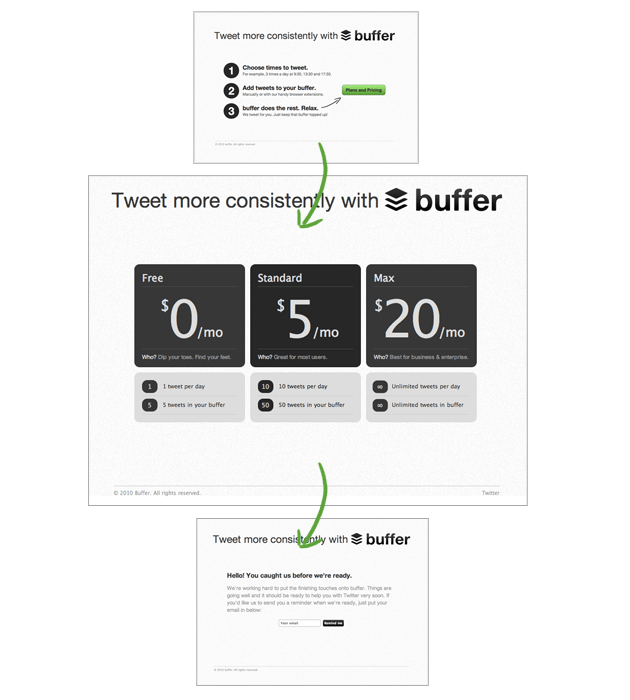
Sales promotion campaigns are short-term initiatives used to stimulate demand for a product or service.
The goal of a sales promotion campaign is to increase sales. Think flash sales, limited-time offers, seasonal push campaigns, coupons, etc. This is also what advertising campaigns are typically about. The idea is to decrease the friction of making a purchase (price, shipping costs, etc.) and speed up the decision process by creating a sense of urgency.
As temporary discounts often bring fast results, it may be tempting for marketers to use these campaigns on many occasions. This is especially when the company doesn’t meet its sales quota. Yet running these campaigns too often has its downsides: discounts can devalue a brand and make it harder to sell products/services at regular prices in the future.
An alternative to offering discounts is increasing the value of a product. For example, you can add more products to make a bundle, offer some freebies, or provide free shipping.
Example
Toyotathon is Toyota’s annual sales event (since 1969). It takes place in the U.S. at the end of each year.
It’s a really big event; one of the greatest sales promotion campaigns in the country. In December 2020, “toyotathon” was searched for an estimated 35K times in Google. That month, Toyota sold 211,378 vehicles (about 11.5% of its total annual sales).
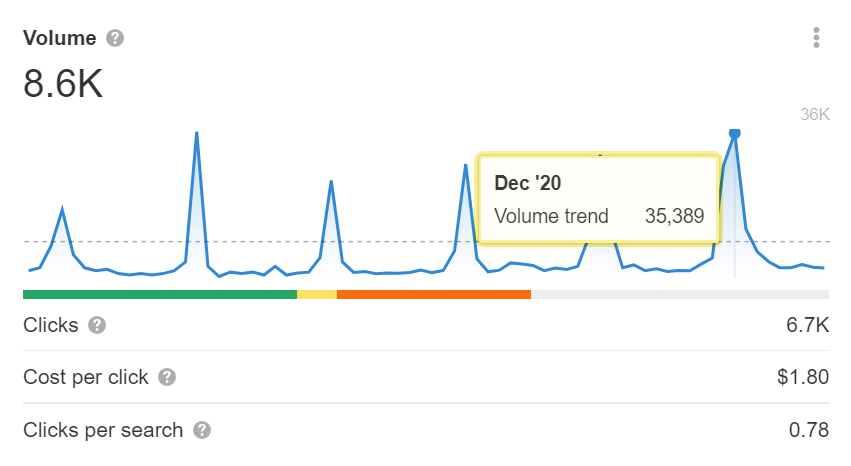
“Toyotathon” search volume. Data via Ahrefs’ Keywords Explorer.
Car manufacturers and dealers hold these kinds of events because when the current year passes, that year’s car stock becomes less valuable (customers prefer newer models). So they try to sell as many cars as possible before the cars lose their value.
As I’ve already mentioned, discounts can undermine the perceived value of the brand and, in this case, the cars. To solve this problem, Toyota has created a sort of a separate brand for discounted cars. That way, customers are not just buying a discounted Toyota. They’re taking part in a Toyotathon.
Brand awareness campaigns highlight the brand and what it stands for to improve its recognizability among the target audience.
Essentially, brand awareness campaigns are more subtle, often indirect ways that impact sales. So instead of offering discounts, marketers will remind their audience that their brand is climate-neutral, designed for people who aren’t afraid to “think different,” etc.

Price is not the only factor that motivates consumer behavior. Sometimes, we buy things because they make us feel good. Or maybe it’s because a company shares our values. Or perhaps the product makes us feel like we joined an elite club. Other times, it’s an emotion we just can’t explain.
Brands are these emotional and cognitive triggers that are used to evoke those various purchase factors. And the more consumers are aware of a given brand, the more likely they are to recall it when shopping.
Another thing about building brand awareness is it works best when it’s a systematic effort. The cost of “forgetting” a brand can be high. But there are ways to save a brand from oblivion even when the timing isn’t ideal for consumers to make a purchase.
A special kind of brand awareness campaigns are rebranding campaigns. These are introduced when a business wants to be identified with a different set of symbols (logos, colors, sounds, etc.) and a different set of associations (values, emotions, benefits, etc.). We’ll talk about them in a bit.
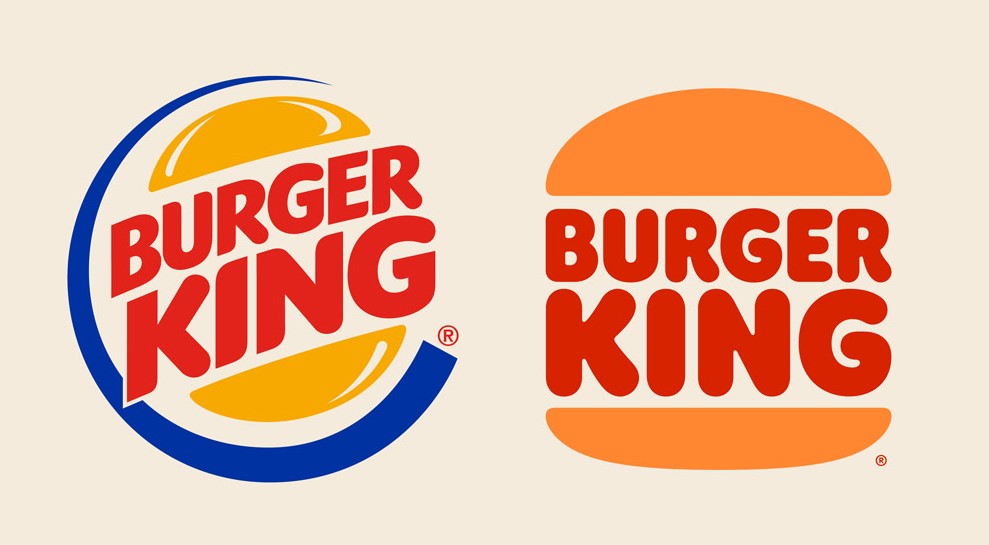
Burger King 2021 Rebranding. Source: Think Marketing Magazine
Example
Nobody promotes cold drinks in the cold season better than Coca-Cola. The Coca-Cola Santa, the truck, the polar bears—these are the brand codes consumers have been exposed to for decades.

There is even a dedicated page on the brand’s website that answers the question: “Did Coca-Cola create Santa Claus?” Amazingly enough, this page gets an estimated 900 monthly organic visits in the U.S. alone.
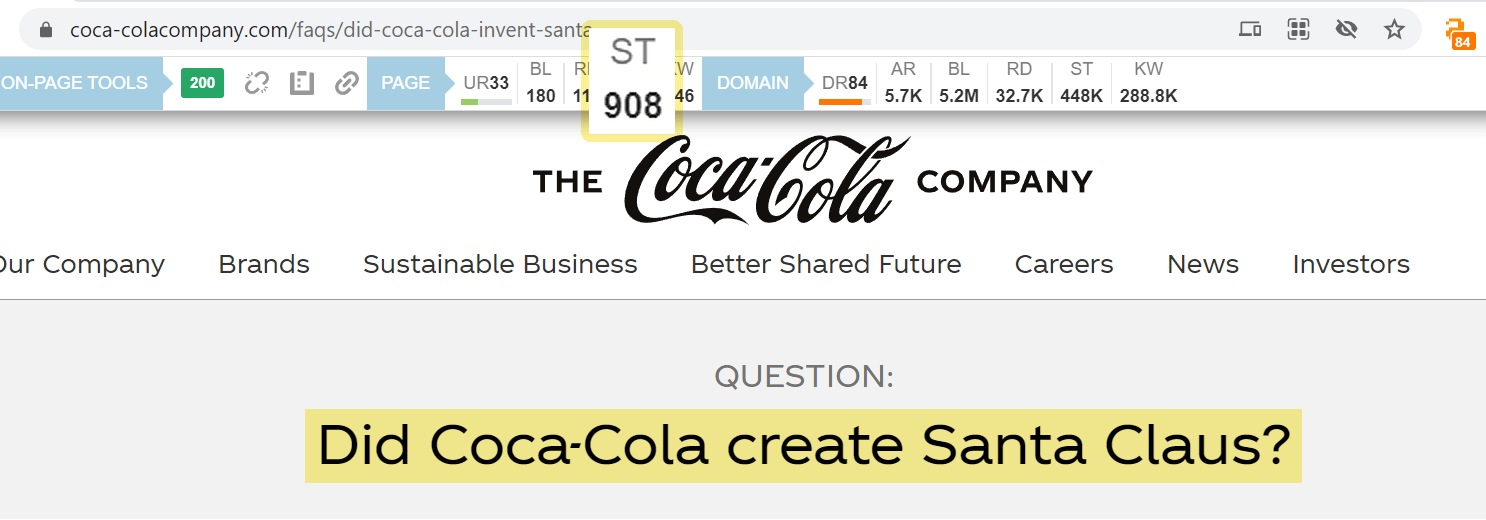
Data via Ahrefs’ SEO Toolbar.
During those multimillion-dollar campaigns, Coca-Cola doesn’t do hard selling. Instead, it tries to find its way to our tables by introducing its brand.
With their famous Christmas campaigns, Coca-Cola tries to create a mental association between the brand and the Christmas season. If Coke can be associated with Christmas, it can be associated with the emotions this holiday evokes.
And those typically are the joy, warmth, and safety of a community. These emotions are important parts of Coca-Cola’s brand positioning.
A rebranding campaign is when a company changes how it looks and what it says about itself to feel new and exciting.
Rebranding can be necessary for several reasons. Sometimes companies need to modernize their image to stay relevant in a changing market. Other times, they might want to distance themselves from past controversies or highlight new products and services they offer. It’s a strategic move to ensure the brand remains appealing and competitive.
Example
In 2021, Kia car manufacturer underwent a rebranding to signify its commitment to innovation.
Known as “Plan S,” our new brand strategy includes an expansion toward sustainable mobility that includes EVs, PBVs, and other mobility solutions and services that enhance the lives of our clientele.
As part of this rebranding, Kia introduced a new logo during a record-breaking light show featuring over 300 drones. However, the redesign received criticism for being unclear, with many mistaking the “IA” in Kia for “KN.”

Source: kia.com
The redesign was criticized for being unclear and confusing. Articles such as “The new Kia logo commits the ultimate design crime” and “Kia’s Logo Redesign Was a Total Flop” reflected the backlash. Many people confused the “IA” in Kia for “KN.”. This even led to a spike in Google searches like “kn car brand” and “kn car price”.

SV stands for search volume in the US, GSV is the global search volume. Data via Ahrefs.
But if you ask me, the new logo’s modern look aligns with Kia’s overall brand strategy focused on electromobility. Kia could just stand back, while other car manufacturers like Peugeot, Renault, and BMW made rebranding efforts to match the futuristic appeal of electric cars.
The thing is, rebranding is a long-term strategy, and reverting to the old logo due to initial criticism would undermine the broader goals. Over time, the criticism faded, as you can see in the search volume data below. Kia’s sales and share price remained stable, and the EV6 model, introduced under the new logo, won multiple awards, including the 2022 Car of the Year.
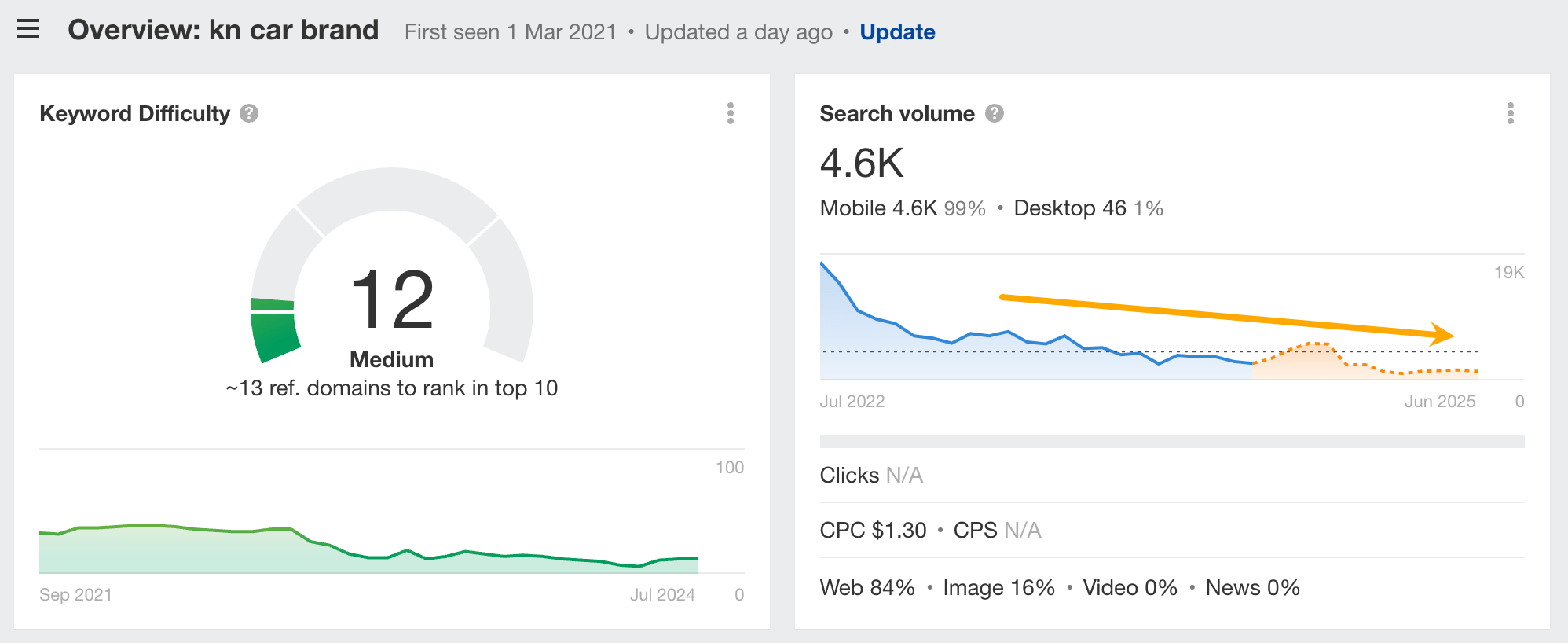
An SEO (Search Engine Optimization) campaign is a series of steps and tactics designed to improve a website’s visibility on search engines like Google. The goal is to get the website to appear higher in search results for specific keywords, making it easier for people to find the website.
By improving the search engine ranking, your website can get to the first page of the search engine results page (SERP) and take advantage of the organic traffic potential.
To illustrate, ranking number #1 for the keyword “backlink checker” and related keywords (like “check backlinks” or “free backlinks checker”) can drive an estimated 14K visits monthly from organic search alone, without any ad spend.
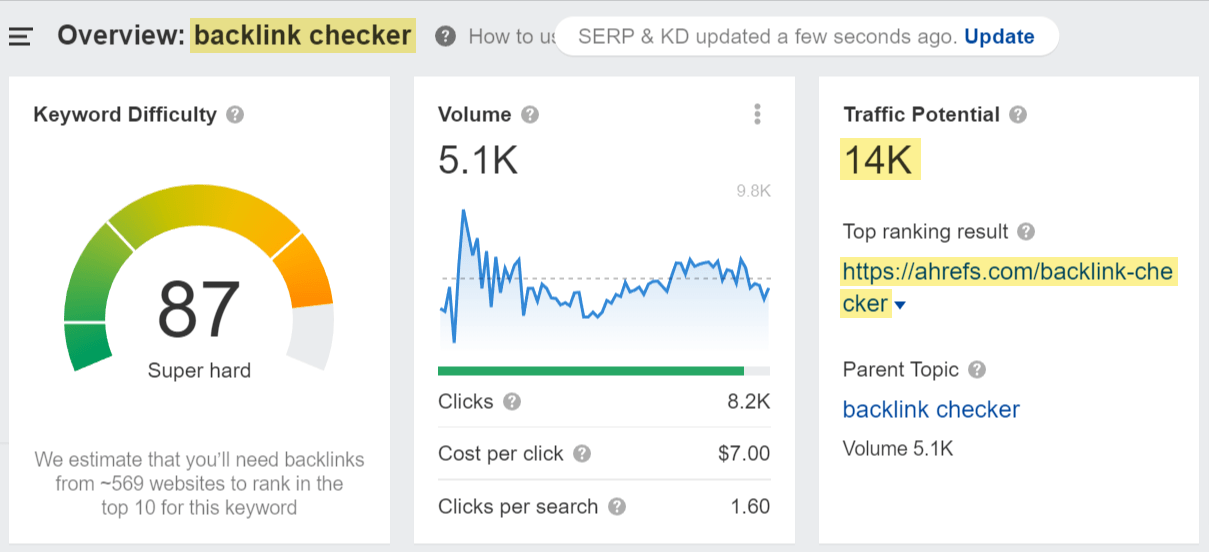
Data via Ahrefs’ Keywords Explorer.
Because search engines like Google use many ranking factors, SEO campaigns can target one or multiple factors to achieve their goal.
Here are some of the known ranking factors:
- Backlinks.
- Relevance.
- Freshness.
- Page speed.
Example
An example of an SEO campaign goal is building links. Links (aka backlinks) are one of the most important ranking factors for search engines like Google. That’s why building links can improve your rankings on the SERPs. And the higher you rank, the more organic traffic you get (generally).
Plus, you can use your links to pass link equity to other pages. SEOs call it the middleman method.
In 2020, Ahrefs ran such a campaign. We created a list of SEO statistics by featuring “link worthy” statistics and then asked other site owners to link to our article.
Once the article was ready, we sent 515 emails and got 36 backlinks from 32 websites. On top of that, our curated list of statistics ranks #1 for “seo statistics” in the U.S. and remains in the top five for related keywords.

We explain the whole process of this SEO link building campaign in this three-part video:
An email marketing campaign is a series of emails sent to a group of people to promote something or share important information.
This type of campaign is often used for the following:
- User onboarding.
- Generating traffic.
- Lead nurturing.
- Sales promotion.
- Newsletters.
- Cart abandonment (example shown below).
The great thing about email marketing is it uses an owned marketing channel to communicate with a “qualified” audience - i.e., people who know your brand and gave permission for direct communication.
Another great thing about email marketing is you can fully automate it by creating workflows engaged (or stopped) based on specified triggers. For example, clicking a link in the email or putting together a list of clients who abandoned their carts. So an email workflow can look something like this:

Example
Cart abandonment emails can help regain 8% of abandoned carts and drive 4% more sales.
Tuft & Needle, a bed products brand, shows how to do a cart abandonment campaign without being too salesy. It sends a three-part email campaign to shoppers who have put products into their cart but left without buying.
The first email empathizes with the customer on the problem of buying the right mattress. The company knows that “mattress shopping sucks” and that it’s OK to take even a few weeks to decide—but not without reading “The 12 answers to your top fears of buying a mattress online” first.
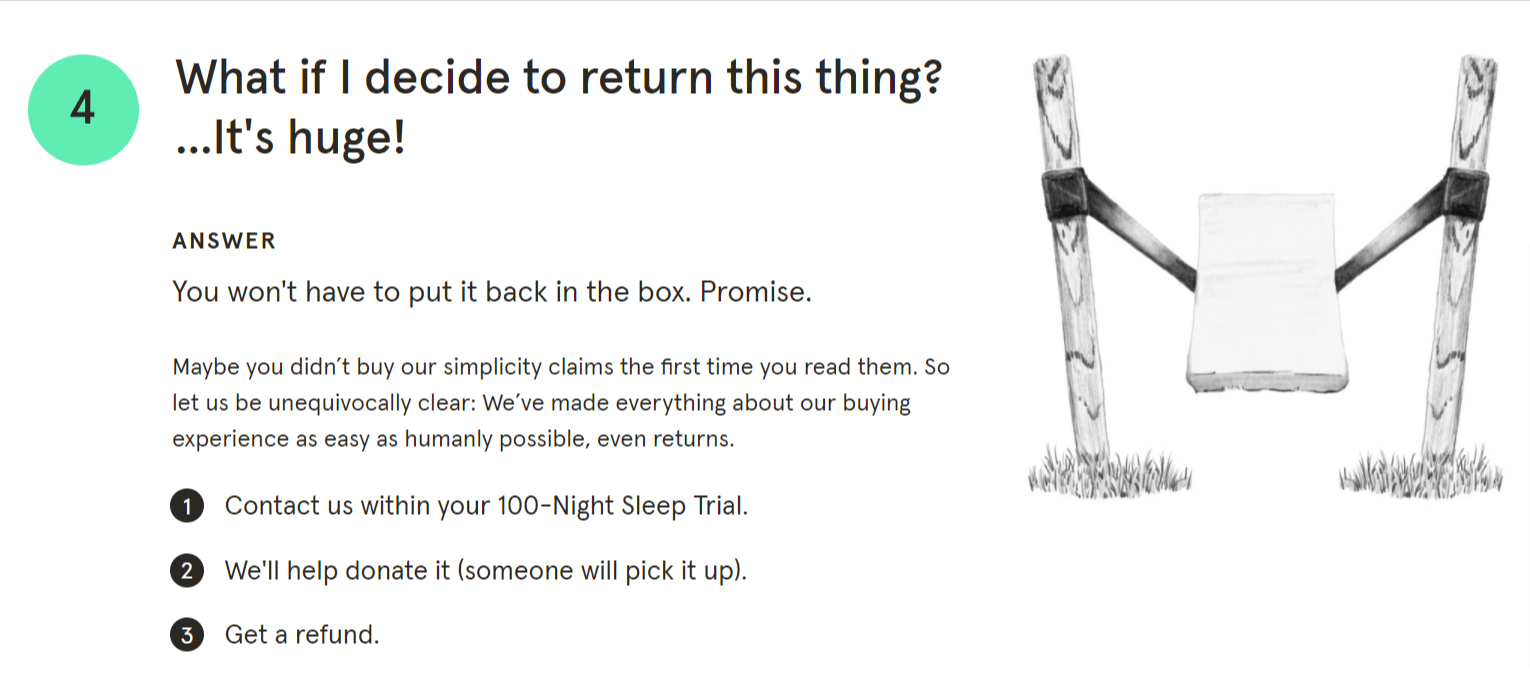
The second email highlights the company’s “value for money” mattresses and introduces an innovative mattress foam. Next, it invites customers to another landing page where it compares Tuft & Needle to other companies.

Finally, in the third email, Tuft & Needle reassures that if the customer doesn’t like the mattress during the first 100 nights, the company will pick it up and reimburse the customer.
Surely, there isn’t much more you can do to win a customer back. If a customer gets “cold feet” in the buying process, there must have been some objections. But if you address those objections and provide reassurance that the purchase is truly risk-free, that may be enough to get that customer back on the purchase path.
While we’re at it, here’s a word of caution for offering discounts in cart abandonment emails. Follow Tuft & Needles’ example and don’t offer discounts at this point, as this may quickly backfire. Imagine your customers discovering this way of getting discounts and abandoning carts on purpose.
A social media campaign is a coordinated effort to promote a product, service, or message across social media platforms like Facebook, Instagram, Twitter, TikTok, and LinkedIn. The goal is to engage with the audience, increase brand awareness, and drive specific actions such as website visits, purchases, or sign-ups.
Like email marketing, social media allows you to interact directly with an audience who follows your brand.
But unlike email, messages on social media can spread quickly beyond your followers to reach a huge audience. (Note: Organic reach has been decreasing over the years, especially on Facebook and Instagram.)
What’s more, on social media you can amplify your message with paid advertising. To do that, you can take advantage of targeting based on many factors, such as location, age, or interest.
Social media offers many possibilities, making it a great fit for different kinds of goals, including:
- Generating traffic.
- Building a community.
- Building brand awareness.
- Generating revenue.
- Encouraging user-generated content.
Example
Apple started its Instagram account in 2017 with the #shotoniphone campaign. In this campaign (still ongoing), the company has been posting quality photos and videos taken on iPhones. It’s a great way to promote those crucial selling points of its products.
Additionally, Apple encourages Instagram users to share their iPhone-made photography under the same hashtag.

This idea to employ user generated content has been wildly successful for Apple To this day, the #shotoniphone campaign has featured over 28 million posts.
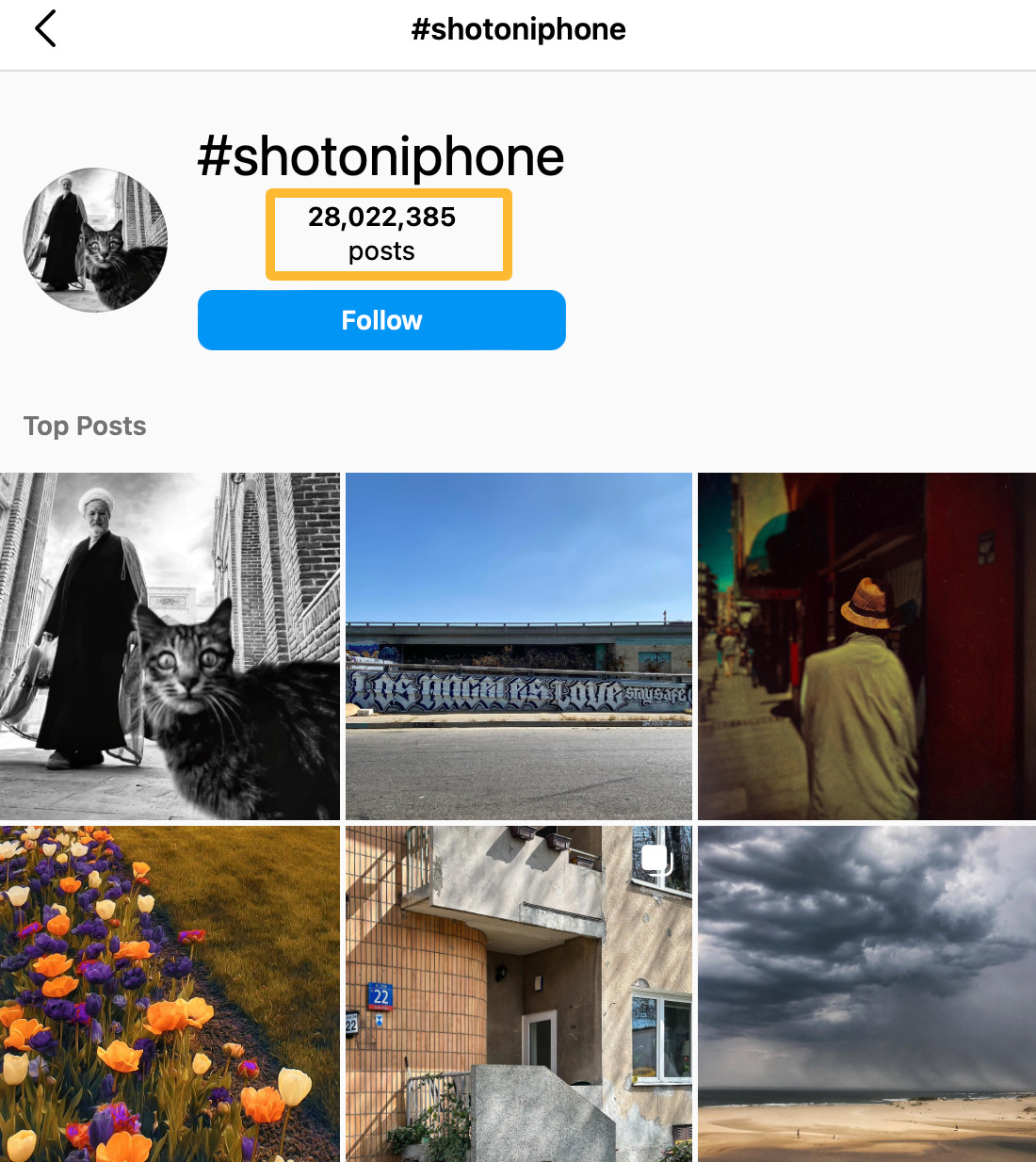
A PR (Public Relations) campaign is a series of activities aimed at improving the public image and reputation of a company, product, or individual. It’s about managing how information is communicated to the public and ensuring that the organization is seen in a positive light.
Whether PR can be deemed as part of marketing is debatable. But what is certain is that PR campaigns, just like marketing campaigns, can affect the demand for a product and, hence, significantly impact sales.
What is unique about PR, though, is it uses a different type of communication compared to marketing.
For instance, while marketing campaigns are notorious for generating demand directly via discounts and all sorts of “special deals,” PR campaigns are never about that.
Instead, a PR campaign will generate demand by sending out press releases highlighting how a product or the company itself is noteworthy.
PR campaigns are especially effective for:
- Promoting an idea important to the brand.
- Building brand image.
- Increasing brand credibility and status.
- Providing added value.
- Inspiring word of mouth.
- Getting attention from the media (and taking advantage of their reach).
Example
“Dumb Ways to Die” was an awarded PR campaign promoting railway safety in Australia. According to the creative director of the campaign, “The aim of this campaign is to engage an audience that really doesn’t want to hear any kind of safety message, and we think dumb ways to die will.”
As you can see, the campaign is a creative and humorous approach to the problem of railroad accidents. It makes you think about death in a way that is, let’s say, bearable. This is so you could actually imagine how dumb it would be to die in one of the depicted ways.
While this campaign has been criticized by some for the risk of causing the opposite effect, “Dumb Ways to Die” gained a lot of industry acclaim (most awarded campaign in Cannes Lions ever) and even went viral.
What’s more, the campaign is said to have reduced “near-miss” railroad accidents by 30% in Australia.
A 360-degree marketing campaign is an all-encompassing approach that uses multiple channels and tactics to deliver a consistent and unified message across various platforms. The goal is to create a cohesive experience for the audience, ensuring that wherever they encounter the brand, the message is the same.
To compare, while social media and email campaigns use one channel, 360 marketing campaigns use both of these channels and more to get the message across.
Furthermore, some other types of campaigns, such as the product marketing campaigns discussed earlier, can become 360 campaigns as long as they use multiple channels and have a unified message.
Multiple channels and a cohesive message - these may sound quite trivial. But campaigns designed this way have two advantages over their single-channel alternatives:
- More marketing channels mean more people reached during the campaign and more convenience for your potential clients to contact you.
- One cohesive message repeated multiple times is easier to understand, remember, and act upon.
These two advantages make 360 campaigns ideal candidates for rebranding, introducing a new product, or simply maximizing the reach and impact of your message.
Example
At Ahrefs, one of the things we promote most often is our Ahrefs Webmaster Tools (AWT) which is free a tool for search engine optimization. We promote it through an always-on, integrated campaign, spanning all of our marketing channels. Here are a few examples of the campaign’s components.
Starting from organic search, we can see AWT’ landing page gets an estimated 1.7K organic search visits each month. This is passive, relevant traffic we get from search engine page results without any ad spend.

Data via Ahrefs’ Site Explorer.
Furthermore, we promote AWT through content marketing. And since we mostly focus on SEO-related topics, we have all sorts of occasions to feature our product.
To illustrate, this article on SEO for startups provided an opportunity to mention the tool as an easy, beginner-friendly way to tackle technical SEO problems.
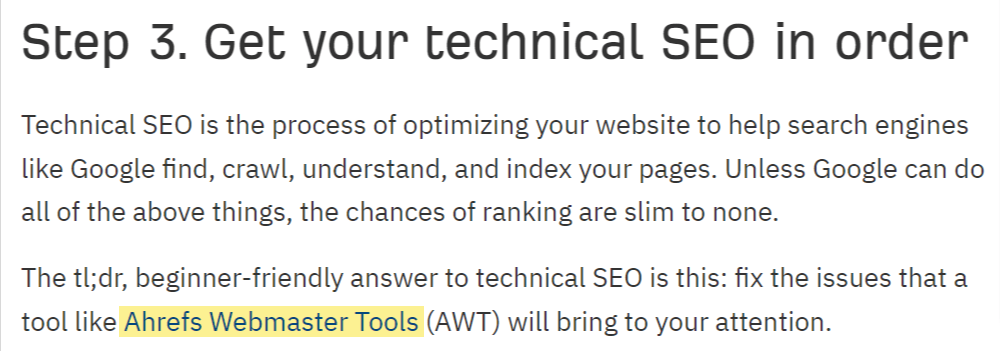
Naturally, there is also educational content dedicated to this product, such as this video explaining how to use it to improve SEO:
In addition to organic channels, we also promote AWT via various paid channels. One of them is sponsorship. Here’s an excerpt of a sponsored newsletter sent by one of the biggest magazines in the SEO industry, Search Engine Journal.
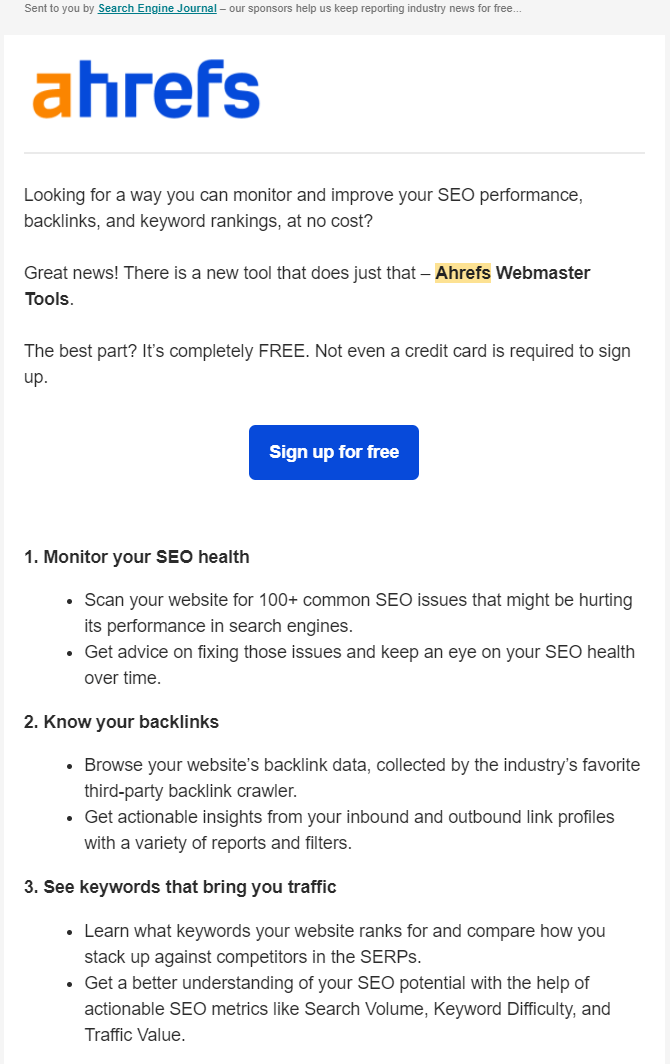
This kind of message can result in more sign-ups for our product because:
- Search Engine Journal attracts a qualified audience for a product like ours.
- Our call to action is focused on getting people to try out a free product. The act of asking someone (who’s not even on our subscriber list) to commit to a paid subscription just because we sent them an email would cause a lot more friction.
Final thoughts
Different campaign types serve different goals. But in order to be successful any marketing campaign has to include these components:
- Goal. The desired direct result the campaign should achieve. Example: launch a new product.
- Audience. The people who should receive your message. Example: contacts in your email list.
- Channels: How you will deliver your message. Example: email.
- Offer. What do you want your audience to do; the call-to-action. Example: visit the landing page and use the signup form.
- Message. How will you tell your audience about it. Example: focus on benefits they won’t get anywhere else for free.
- Budget. How much time and money you can spend on everything included in the campaign.
Got questions? Ping me on Twitter or LinkedIn.
